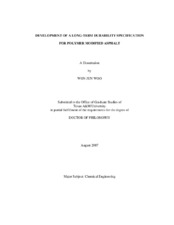| dc.description.abstract | In recent years an increased use of polymers has occurred to modify asphalt
binders, mainly to decrease pavement rutting but also to improve binder failure strain in
direct tension. Whereas all of these effects positively impact the durability of polymermodified
pavements, a need exists to quantify these improvements and the duration in
the presence of oxidative aging.
This research evaluated the durability of polymer modified asphalt (PMA)
through a number of determinations that included the characterization of the original
binder property and pavement-aged binder for modified and unmodified binders.
Changes in styrene-butadiene-styrene (SBS) polymer modified binder properties
from oxidation were analyzed using dynamic shear rheometry, ductility, and force
ductility. Previous literature reports using size exclusion chromatography showed that
degradation of the molecular weight profile of SBS accompanied the loss of PMA
ductility. Yet base binder embrittlement also occurred, as evidenced by ductility and
force ductility. Testing aged PMA binders at higher temperatures to soften the base
binder restored the polymer modulus to the force ductility measurements as did blending
with a softer deasphalted oil. These measurements indicate that the more significant
cause of PMA degradation with aging is base binder embrittlement rather than polymer
degradation.
Sixteen pavements in 11 Texas Districts, plus four MnRoad pavements were
evaluated in order to obtain a more detailed profile of binder oxidation in pavements.
Slices of each core provided detail on binder oxidation and air voids. The data confirm that binders can oxidize at least several inches into the pavement. However, oxidation
also can be significantly slowed, apparently by very low accessible air voids.
Interestingly, the data indicate that the air voids that are relevant to the binder at a
specific depth of the pavement are those in the immediate vicinity of the binder; low air
voids above or below the binder do not seem to significantly affect the binder oxidation
rate. Furthermore, that binders oxidize inches below the surface shows that temperature
conducts well into the pavement, consistent with a heat conduction model that is used to
calculate ground temperatures as a function of depth. | en |


